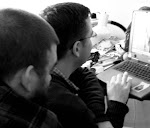
Some weeks back, we received a very good question in a comment: How do you know where the Holy Places are?
The easiest sites are the big ones. Examples of this would the Sea of Galilee, the Dead Sea, the Mount of Olives, Jerusalem and the Temple Mount within Jerusalem. When these are spoken of in Scripture, we know what they are talking about. These sites may look different now, the water level may be higher or lower, but there is no doubt about where they are. It was a very powerful experience to swim in the Sea of Galilee back in early January, knowing that hear the Apostles fished, here they were called.
Next, I would say, we have the key specific spots, like Calvary or the Empty Tomb, or the Church of the Nativity. How do we know they're on the very right spot? It's actually the result of an interesting fillip of history. In 70 AD, Jerusalem was destroyed by the Romans, razed to the ground. They expelled the Jews from the area, and destroyed any Jewish or Christian shrines. However, in order to ensure these sites could not be used for worship, on the most important ones they constructed pagan temples to the Roman gods! For some generations, the city of Jerusalem was known only by the new name, Aelia Capitolina, and many forgot the sacred history. However, in the 4th century, the Emperor Constantine made Christianity legal. He and his mother, Queen Helena, commenced a building spree and built many important churches. In the Holy Land, they were able to dig up the pagan temples, and find the ruins of early churches beneath them! In the end, the Romans' desire to destroy the faith actually monumented these sites for posterity!
Finally, there are other sites where it is much less certain, and where we have little early record. For instance, there are three possible sites for Emmaus. Many agree that Mount Tabor is the sight of the Transfiguration, while some think it is Mount Hermon. Scripture does not always give us clear or unequivocal directions about where things ocurred. It is important to know that the sites are not perfectly certain. At the same time, this does not diminish the opportunity to venerate the tradition and the event at that site.
Before coming, and in the early days of the trip, this was an issue I thought about quite a bit. After a few weeks, though, seeing the River Jordan, the Mount of Olives, and realizing that I was unequivocally and without doubt in the Land of Jesus, I realized that even in the cases where we're not perfectly sure, I was still SO close! He walked through these hills and valleys, along the shores of this lake. The Gospels are certainly not just pretty stories, they actually happened!
The Word was made Flesh, and dwelt among us!
God Bless,
Ben


1 comment:
Ben & Mike,
I think you've done a fantastic job depicting the sights visited based on Biblical / historical data. There's a double edged saying that I struggle with... Think before action, learn before acceptance, decide who you should be. It's a simple saying on the surface but "follow me" "trust in me" "Do not test our God" "Have faith". The lines becomes obscured. I'll probably not make the journey you've been on, but I do believe purely on faith. This doesn't need to be posted. I tend to ramble without direction. Please say a prayer that I don't lose my way.
Your friend in Christ!
Matt
Post a Comment